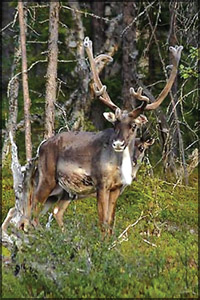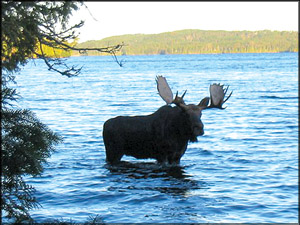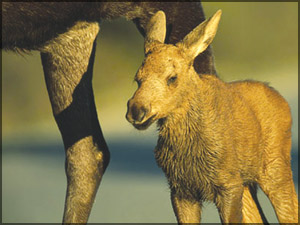
Reindeer and Moose:
The majestic deer
Remember Rudolph,
the Red-nosed Reindeer, who was picked by Santa Claus to draw his
sleigh? Well, we thought that we would enlighten you about Rudolf's
family members and also relatives, the moose, in this issue because they
are the 'deers' in the animal kingdom....
Both reindeer and moose, members of the deer family, are found mostly
in the northern regions of the world.
|

Looking for reindeer moss. |
|

The reindeer is a herbivore. |
The reindeer, also known as caribou, is an Arctic and Sub Arctic deer
and can be seen in northern Scandinavia, Greenland, Canada, Alaska, and
North America.
Both males and females have antlers, which typically, have two
separate groups of points. Females weigh around 60-170 kg (132-375 lbs).
In some sub species the males are larger and weigh around 300 kg.
Ruminants with four-chambered stomachs, reindeer love to eat a type
of lichen called reindeer moss. They also eat the leaves of willow,
birch, saedges, and also grass. Occasionally they are known to include
bird eggs and lemmings in their diet when food is scarce.
Reindeer have specialised hooves which adapt to the changing seasons.
In the summer, when the tundra is soft and wet, their foot-pads become
spongy. These provide extra traction (drawing or pulling power).
However, in the winter, these pads shrink and tighten, exposing the
rim of the hooves. The hooves so exposed enable the reindeer to walk in
the snow without slipping because they cut into the ice-crusted snow.
Perhaps, this is why Santa picked on these creatures to draw his sleigh,
loaded with gifts for so many children.
|

Both males and females have antlers. |
These hooves are useful for them to dig down, which is popularly
known as 'catering', to their favourite food - the reindeer moss. In
fact, the name caribou means 'snow shoveller' and it was this habit of
pawing through the snow for food that earned them this name.
Reindeer are social animals that live in herds and are majestic. They
are highly valued and important animals to the nomadic tribes,
especially the Lapps.
***
Moose (Alees alces)
are the largest members of the deer family and are called the giants of
the deer world.
|

Only male moose have antlers. |
Distributed throughout Canada, Northern USA, Northern Europe as far
east as Siberia, the moose weigh around 200-825 kg (440-1815 lbs) and
reach a length of 2.4-3.1 m (7.8 - 10.1 ft) with a tail of 5.12 cm
(2-5in). At shoulder height, moose can be as tall as 1.4-2.4 m (4.6-7.8
ft). They are indeed huge animals and the males with their large, forked
antlers seem even bigger and majestic.
Unlike reindeer, it is only the male moose that have antlers and they
too are not twig-like configurations (arrangements) most deer species
have. Moose antlers arise as cylindrical beams, projecting on each side
at right angles, to the middle of the skull.
After a brief distance, they divide into fork-like formations which
may be simple or elaborate.
They drop their antlers for the winter to conserve energy and grow a
new set during spring. These antlers take only 3-5 months to fully
develop and are considered to be one of the fastest growing organs in
the world.
|

A moose calf with its mother. |
Initially the horns are covered with a fuzzy skin called velvet which
contains blood vessels that carry nutrients for them to grow. The males
that grow button-like antlers in the early stages, rub off this velvet,
which dries up later.
Moose are solitary animals that are active during the day, especially
at dawn and dusk. Even though they have poor eyesight, they have
excellent hearing and sense of smell.
They feed mostly on aquatic plants like water lilies, woody plants
like twigs and bark of willow, balsam, birch, aspen and dogwood trees.
They lack teeth in the front of the upper jaw, but the plant material
they eat is thoroughly crushed between 12 sets of broad, flattened teeth
at the rear of the mouth. Moose have thick tongues and lips, large
noses, small ears, large nostrils and long heads.
Their large, heavy bodies are supported on spindly(long and slender)
legs which have cloven or divided hooves. Most moose have a pendant of
fur-covered skin about 30 cm long, called a bell, hanging from the
throat.
They have dark brown, almost black to reddish or greyish brown
coloured coats with grey or white leg stockings. well-haired.
Even though massive in size, moose have the ability to move as
silently as cats through dense forests.
***
Fact file
|

Moose have a pendant of fur-covered skin about 30 cm long,
called a bell. |
* Reindeer cows use their antlers to protect the calves. When one (or
several) calves are too weak to avoid a threat, the cows may form a
circle, standing alongside surrounding the young from every side, with
their horns or antlers protruding outward, against the danger.
* Long before recorded history, the Samis developed almost a symbolic
(mutually beneficial) relationship with the reindeer. Aside from the use
as transport, the reindeer were milked and their flesh (including
intestines) were eaten. Reindeer skin is still used for clothes and
shoes.
* Genus and species of this medium-sized member of the deer family
are Rangifer tarandus.
* Reindeer have wide hooves, broad muzzles and thick brown fur. The
thick fur traps air which insulates it from the cold and help keep
afloat when swimming.
* A herbivore (plant eater) the reindeer spends most of the day
eating.
* The fur coat is thin and brown in summer, and thick and grey in
winter. The tail is white and so is the rump.
* Social animals living in herds, they are well adapted to winter
conditions. In the harsh, freezing-cold environment, they live in herds
- the smallest numbering 20 and largest thousands.
* In Alaska, hunters harvest more caribou than any other big game
species.
The herd is almost constantly on the move.
A day-old reindeer can outrun a man.
****
Fact file
* The largest mammal in North America, the moose is also known as the
elk in Europe.
* These animals are distinguished by the special antlers of the
males. These antlers which may be as wide as 4-5 feet across are used
mainly for fighting during the breeding season, rather than for
protection.
* An adult moose will consume about 19.5 kg (43 lb) of vegetation a
day.
* Females give birth to 1-2 calves in the spring.
* Moose are considered to be the national animal of Sweden and
Norway. The crown-like antlers have led to it being called the 'King of
the forest'
* They are hunted as game (food). European rock drawings and cave
paintings have proved that these animals have been hunted since the
Stone Age.
* In USA's state of Maine, the moose is the state animal and in
Alaska it is the state's land mammal.
* Moose, like reindeer are domesticated and records show the
possibility of domesticating these animals was investigated as far back
as the World War II.
* Moose survive the cold well, but suffer from heat.
* They beat the heat by submerging themselves in cool water. They are
good swimmers and can swim up to two hours as far as 12 miles.
* New-born calves communicate with a low grunt, but as they grow, the
moose develop a strident wail which sounds almost human.
* The new-borns stand up within a day and swim within a couple of
weeks. They are weaned after six months but choose to stay with the
mother until the next young are born.
* Moose can run at speeds of 35 miles per hour. |
